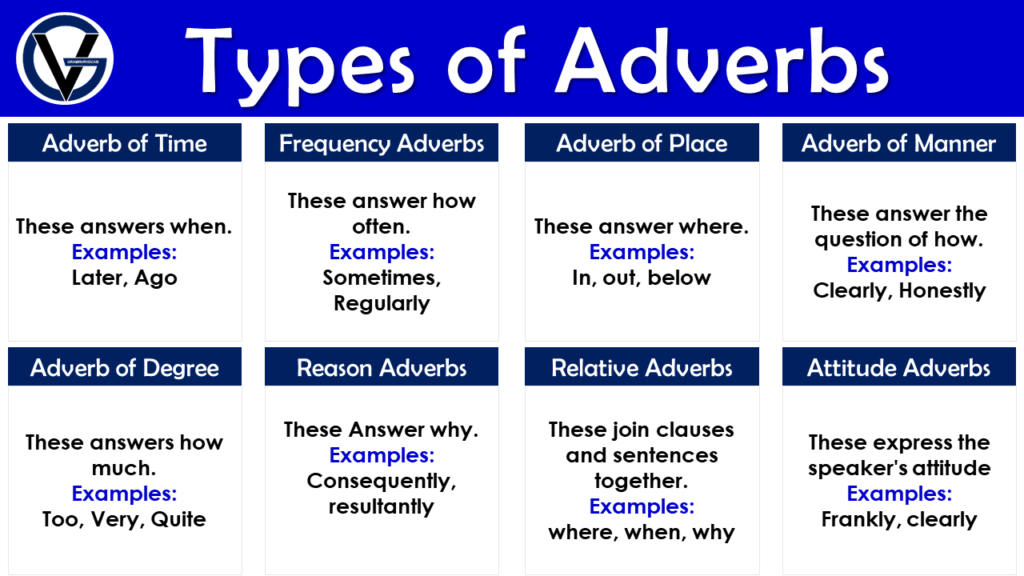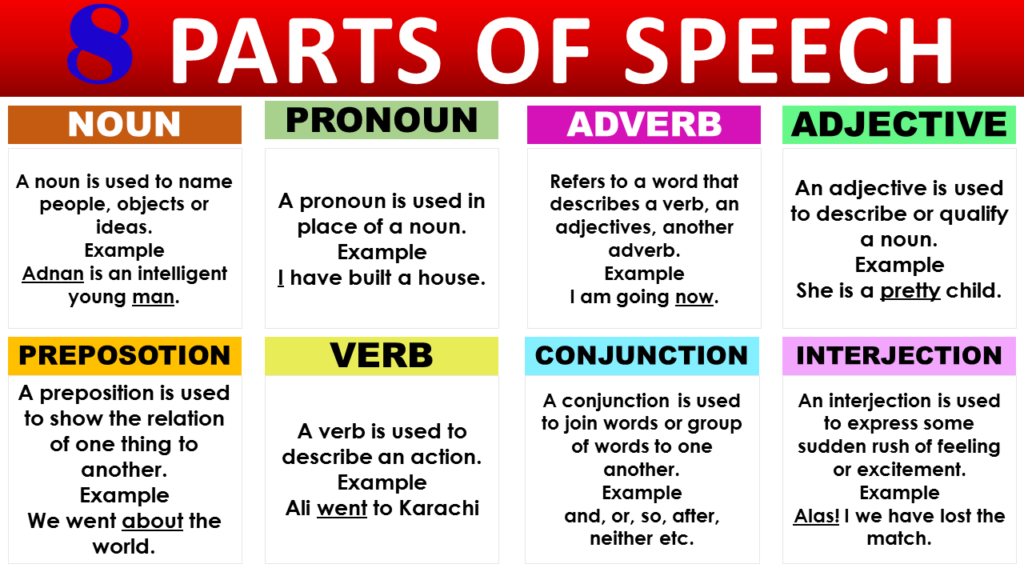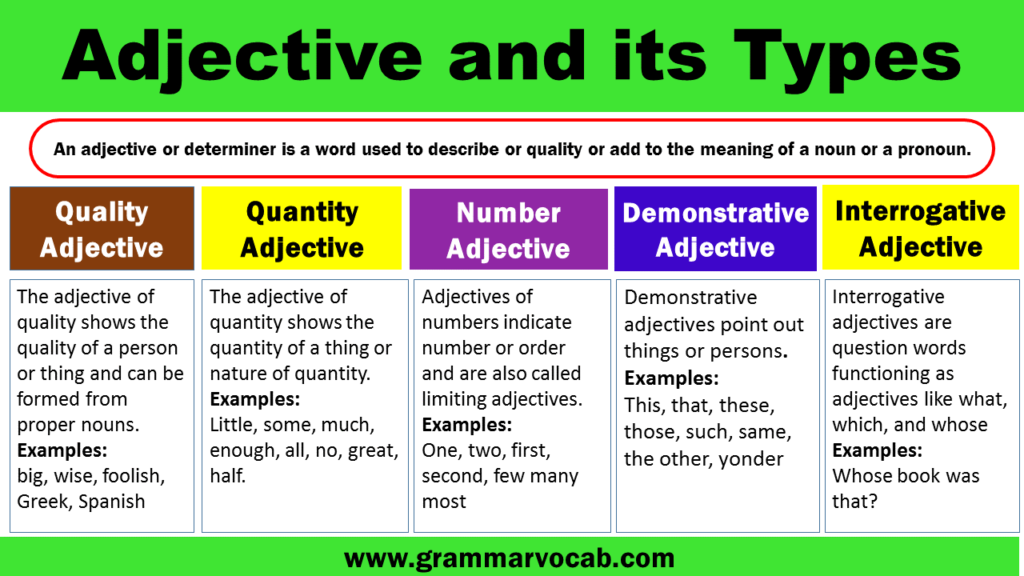Adverbs are versatile and essential components of the English language. They play a crucial role in modifying various elements in a sentence, providing additional information about how, when, where, or to what degree an action occurs. Understanding the different kinds of adverbs and their examples is essential for effective communication and writing. In this comprehensive guide, we will explore the various types of adverbs and provide numerous examples to illustrate their usage.
Define Adverb
An adverb adds to the meaning of a verb, adjective, or some other adverb. An adverb, in fact, qualifies any part of speech except a noun or a pronoun.
- Slowly, quickly, wonderfully, mostly, beautifully, sweetly, bitterly, very, mostly.
He answers correctly.
Here correctly describes the verb replied.
She talked interestingly.
Note:
- She fought bravely against the difficulties of life and succeeded in the end. The tower was surprisingly tall. They cried very loudly.
- The adverb bravely qualifies the verb fought. Surprisingly qualities the adjective tall very qualifies the adverb loudly.
Kinds of Adverbs
An adverb answers the question of how, when, how often, where, under what conditions, or in what manner.
Adverbs of manner
Adverbs of manner describe how an action is performed. They answer the question, “How?” Here are some common examples:
- Quickly: She completed the marathon quickly.
- Carefully: He handled the fragile glassware carefully.
- Effortlessly: The gymnast executed the routine effortlessly.
- Loudly: The thunder rumbled loudly.
These adverbs provide additional information about the action, helping the reader or listener visualize the manner in which it occurred.
Adverbs of degree
Adverbs of degree modify adjectives or other adverbs by indicating the extent or degree of an action. They answer the question, “To what extent?” or “How much?” Here are some examples:
- Very: She is very talented.
- Too: The coffee is too hot.
- Quite: The movie was quite interesting.
- Almost: He’s almost finished with his work.
These adverbs add nuance and precision to descriptions.
Adverbs of time
Adverbs of time are words that describe when an action takes place. They provide information about the timing of an event, and they can be used to answer questions like “When?” or “How often?” Here are some common adverbs of time with examples:
Now: The action is happening at this moment.
-
- She is studying now.
Today: On the current day.
-
- I have a meeting today.
Yesterday: The day before today.
-
- We went to the park yesterday.
Tomorrow: The day after today.
-
- I have an appointment tomorrow.
Soon: In a short while or in the near future.
-
- The movie will start soon.
Later: After some time from now.
-
- I will call you later.
Before: Earlier in time.
-
- Please arrive before 5 PM.
After: Subsequent to a particular time.
-
- We can meet after lunch.
Always: At all times or on every occasion.
-
- She always arrives early.
Daily: Every day.
-
- She reads the newspaper daily.
Weekly: Every week.
-
- We have a staff meeting weekly.
Seldom: Rarely or infrequently.
-
- She seldom visits her relatives.
Frequently: Often or regularly.
-
- They frequently travel for work.
Occasionally: From time to time, not regularly.
-
- I go swimming occasionally.
Since: From a specific time in the past to the present.
-
- She has been working here since 2010.
Adverbs of place
Adverbs of place specify the location or direction of an action. They answer the question, “Where?” Here are some common examples:
- Here: The keys are here.
- Everywhere: They searched everywhere for the lost dog.
- Upstairs: She’s upstairs studying.
- Abroad: They love to travel abroad.
These adverbs help paint a picture of the spatial aspect of an action.
Adverbs of cause or reason
Adverbs of cause or reason are adverbs that provide information about why something happened or the reason behind an action or event. These adverbs help to explain the cause or motive behind an action. Here are some common adverbs of cause or reason along with examples:
Therefore: Indicates a logical consequence or result of something.
-
- She studied hard; therefore, she passed the exam.
Consequently: Shows a cause-and-effect relationship.
-
- The rain was heavy; consequently, the streets were flooded.
Thus: Expresses a conclusion or outcome.
-
- He saved a lot of money; thus, he could afford a new car.
Hence: Denotes a reason for an action or event.
-
- She was feeling unwell; hence, she couldn’t attend the meeting.
Because: A common conjunction but can function as an adverb when used at the beginning of a sentence to explain the reason.
-
- Because it was raining, they decided to stay indoors.
So: Indicates a cause-and-effect relationship or reason.
-
- She was tired, so she went to bed early.
Because of this: Emphasizes the cause or reason for an action.
-
- Because of this delay, the flight was rescheduled.
Adverbs positive and negative
Adverbs can be categorized as either positive or negative based on their meaning and the way they modify verbs, adjectives, or other adverbs. Positive adverbs enhance or intensify the action, adjective, or adverb they modify, while negative adverbs diminish or weaken it. Here are some examples of positive and negative adverbs:
Positive Adverbs:
- Quickly: He completed the task quickly.
- Very: She is very talented.
- Well: She sings very well.
- Certainly: I will certainly help you.
Negative Adverbs:
- Slowly: He walked slowly.
- Hardly: He hardly studied for the exam.
- Barely: She barely made it on time.
- Not: She’s not happy with the results.
Adverbs of frequency
Adverbs of frequency describe how often an action occurs. They help provide context and clarity in communication. Here are some common adverbs of frequency:
-
Always: This adverb indicates that an action happens all the time, without exception. For example, “She always arrives early for work.”
-
Usually: It suggests that an action occurs frequently, but not constantly. “He usually eats breakfast at home.”
-
Often: This adverb implies a high frequency of occurrence, more than just usually. “They often go for a walk in the evening.”
-
Sometimes: It signifies occasional occurrences. “I sometimes watch movies on weekends.”
-
Rarely: This indicates infrequent events. “He rarely misses his appointments.”
Adverb of Affirmation
An adverb of affirmation is a word that is used to express agreement, approval, or confirmation. These adverbs are used to confirm the truth or accuracy of a statement or to show a positive attitude toward something. Some common adverbs of affirmation include:
- Certainly
- Definitely
- Absolutely
- Surely
- Indeed
- Positively
- Undoubtedly
- Naturally
- Affirmatively
- Unquestionably
Interrogative Adverbs
Interrogative adverbs are words that are used to introduce questions and typically seek information about various aspects of a sentence, such as time, place, manner, reason, or degree. These adverbs are commonly found at the beginning of a question and help specify the details the speaker or writer is interested in. Some common interrogative adverbs include:
When: Asks about the timing or a specific point in time.
-
- When did you arrive?
Where: Asks about the location or place.
-
- Where is the nearest coffee shop?
How: Inquires about the manner, method, or condition.
-
- How did you solve the problem?
Why: Seeks the reason or cause.
-
- Why are you late?
Relative Adverbs
Relative adverbs are words that introduce relative clauses in a sentence. Relative clauses are subordinate clauses that provide additional information about a noun in the main clause. Relative adverbs typically serve to describe the time, place, or reason of the action in the relative clause. The most common relative adverbs are “when,” “where,” and “why.”
When: This relative adverb refers to a specific time or period. It introduces relative clauses that describe the timing of an action.
-
- Example: The day when I met her was unforgettable.
Where: “Where” is a relative adverb that relates to a specific place or location. It introduces relative clauses that describe the location of an action.
-
- Example: The park where we had our picnic was beautiful.
Why: “Why” is a relative adverb that indicates the reason or cause behind an action. It introduces relative clauses that explain the reason for something happening.
-
- Example: I don’t understand the reason why he left so suddenly.
Adverbs in Comparative and Superlative Forms
When comparing two or more things, adverbs can also take comparative and superlative forms to indicate a higher or lower degree of the quality described. Here are some examples:
- Comparative: She dances more gracefully than her sister.
- Superlative: She dances most gracefully of all.
In these examples, “more” and “most” are used to create comparative and superlative forms of the adverb “gracefully.”
Commonly Confused Adverbs
Certain adverbs are commonly confused due to their similar meanings or spellings. Here are some examples of frequently confused adverbs:
Hardly vs. Barely:
-
-
Hardly means scarcely or almost not at all.
-
Barely means only just or hardly.
-
He hardly ate anything at the party.
-
She barely passed the exam.
-
Already vs. All Ready:
-
-
Already means prior to a specified time.
-
All ready means completely prepared.
-
I had already finished my homework.
-
We are all ready for the trip.
-
Farther vs. Further:
-
-
Farther refers to physical distance.
-
Further relates to degree or extent.
-
The store is farther down the road.
-
We need to discuss this matter further.
-
Being aware of these distinctions can help you use adverbs correctly in your writing.
Using Adverbs to Modify Adjectives
Adverbs can also modify adjectives to provide more specific information about the quality of a noun. When adverbs modify adjectives, they answer the question, “To what extent?” Here are some examples:
- Very talented: He is very talented.
- Extremely beautiful: The sunset was extremely beautiful.
- Incredibly difficult: The exam was incredibly difficult.
- Surprisingly good: The movie was surprisingly good.
In these examples, adverbs like “very,” “extremely,” “incredibly,” and “surprisingly” intensify the adjectives “talented,” “beautiful,” “difficult,” and “good.”
Must Try:
List of Suffixes for Adverbs
List of Strong Adverbs
List of Conjunctive Adverbs
Images
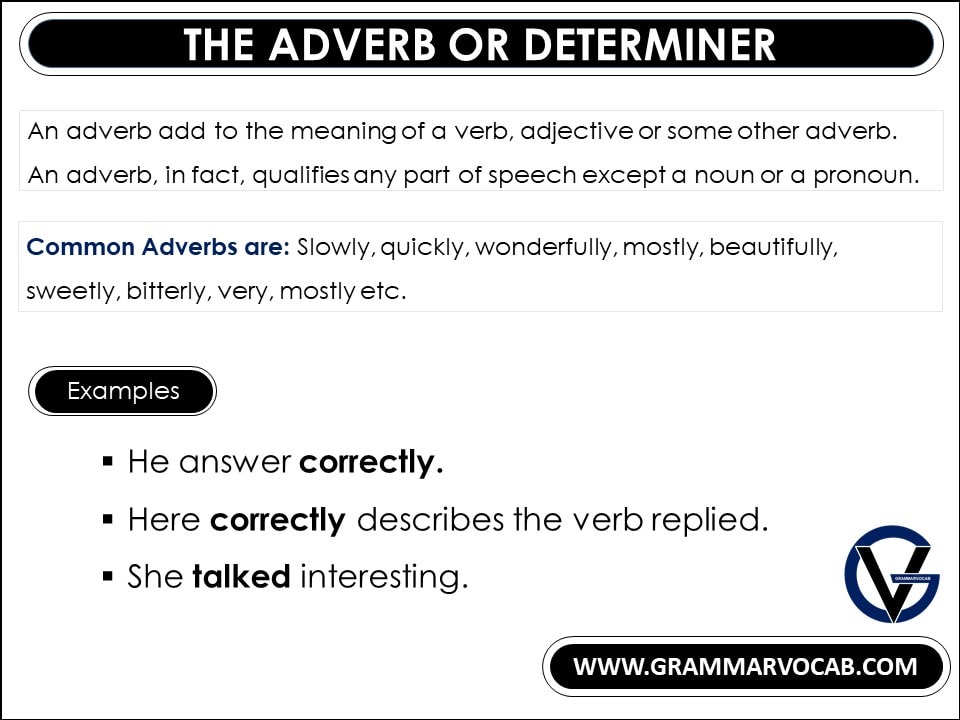
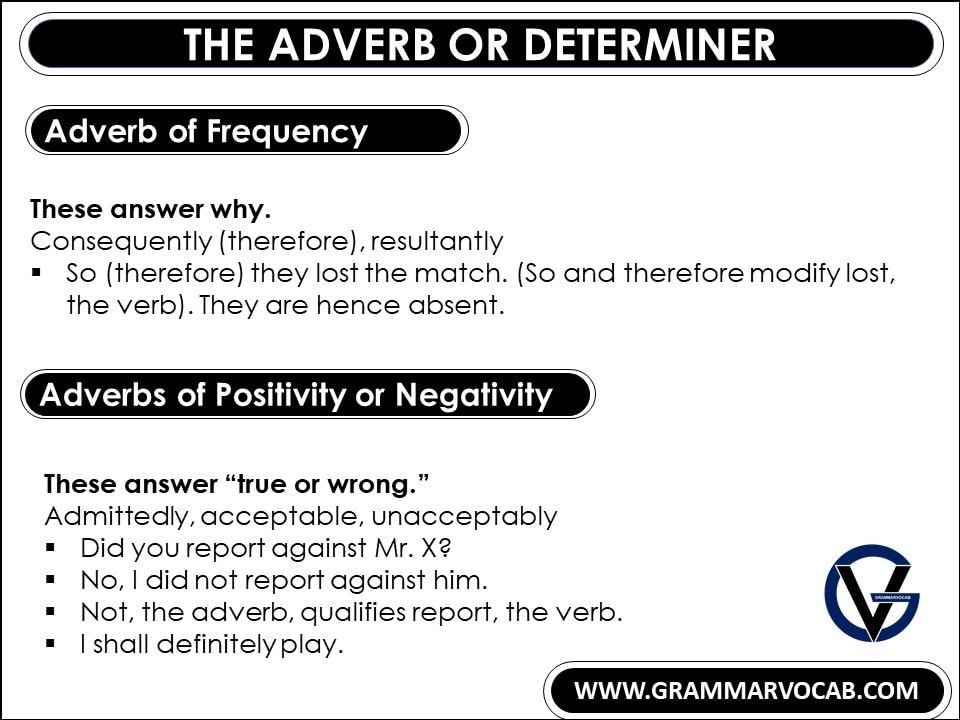
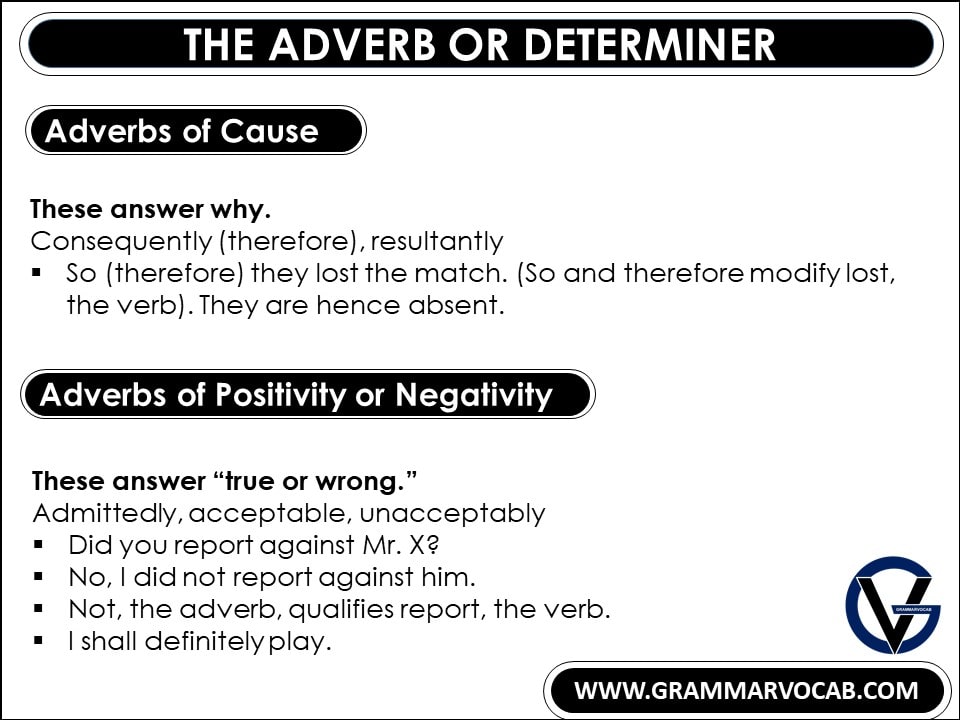
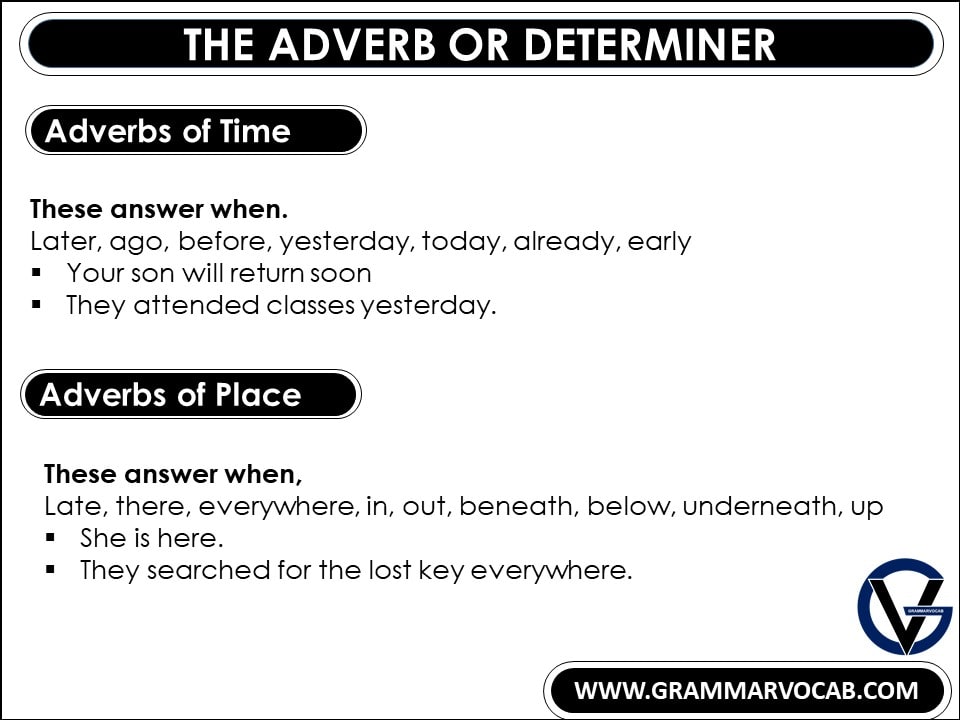
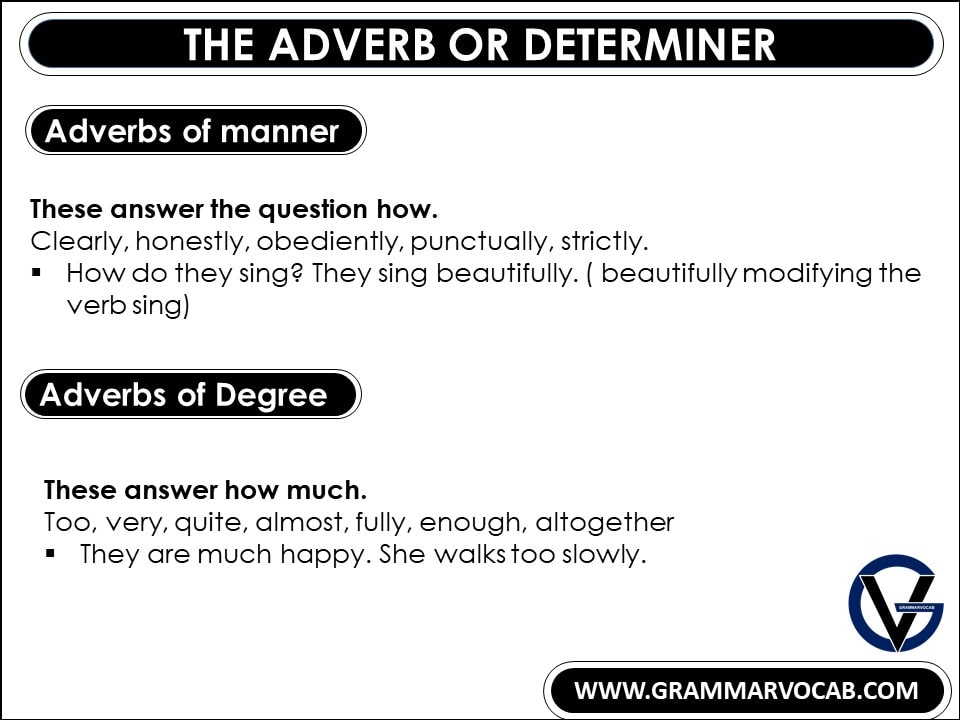
FAQs Related to Types of Adverbs
What are the actual types of adverbs?
Adverbs are of 10 types in actual and we have discuss 10 types of adverbs in this lesson along with examples and Infographic PDF.
Here are the 10 kinds of adverbs in English:
1. Adverb of Time
2. Adverb of Place
3. Adverb of Attitude
4. Adverb of Manner
5. Adverb of Affirmation
6. Interrogative Adverbs
7. Adverbs of Frequency
8. Adverb of Degree
9. Adverb of Reason
10. Relative Adverbs
What type of adverb is only?
Only is a focusing adverb, focusing adverbs are those adverbs that are used to give a special attention to something or to describe and modify something special.
How do you identify an adverb in a sentence?
To identify an adverb you have to implement the definition of adverb onto the sentence. ” Adverb is a word that modifies a verb, adjective or another adverb”. Following this definition you can easily figure out out adverb in a sentence. Another way to understand adverbs by going through this powerful list of adverbs.
